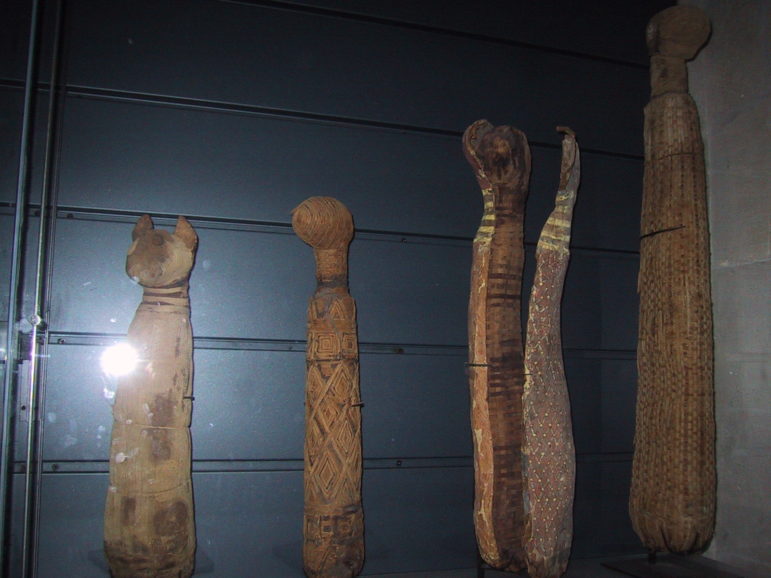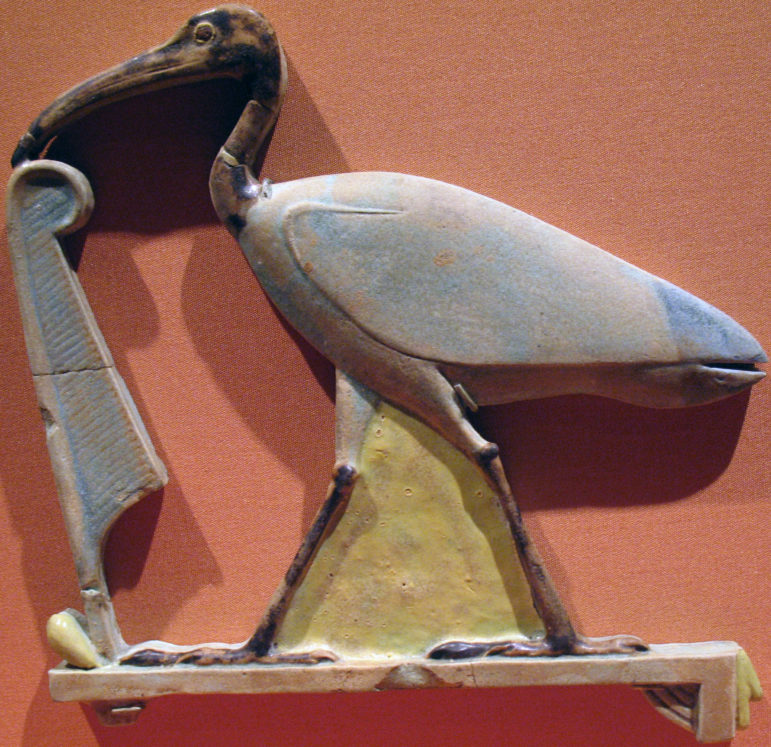TWH – In Egypt, archaeologists have found more animal mummies than humans. Cats, crocodiles, mice, mongooses, and millions of ibis birds all underwent mummification.
Archaeologists have recently examined ibis mummies to resolve two questions.
First, given a large number of bird mummies, how did Egyptian priests obtain so many? Public Library of Science in their open-access research publication, ONE(PLOS/ONE), reported on this first question last week. It built upon a second question, when did they mummify these birds? Research on this second question was conducted a few years, “Radiocarbon dating of Sacred Ibis mummies from ancient Egypt”.

[Cat mummies at the Louvre – Image credit: Zubro, 200 – Wikicommons]
Four types of animal mummies
Archaeologists have found four types of animal mummies in ancient Egypt: 1) beloved pets, 2) food for the afterlife, 3) votive offerings, and 4) animal-as-god.
Priests mummified beloved pets. There are two possibilities of how these pet’s lives ended so they could be mummified and continue on as companions in the afterlife. They could have died natural deaths, and then were mummified to be eventually buried with the owner.
Another possibility is that when their owner died, temple priests could have taken their lives so they could be mummified and interred with their owner and placed among the grave goods.
Like other grave goods, they would then serve the deceased in the afterlife. The “beloved pets” of this life would become the “beloved companions” of the afterlife.
Ancient Egyptians placed other mummified animals among the grave goods. These mummies would’ve reflected the purpose of providing food for the deceased in the afterlife.
Priests would sacrifice other animals as votive offerings to fulfill a prayer.
In contrast, some animals would embody the animal-as-god concept. People would treat these animals as gods. In at least one case, the animal-as-god-incarnate received veterinary care. These animals would die a natural death. The priests of temple would bury them in elaborate coffins.
The number of votive offering mummies greatly exceeds that of animal-as-god mummies.
Thoth or Djehuty

[Thoth depicted as an Ibis created by an unknown artist in Ancient Egypt – anagoria, Public Domain, Wikicommons]
The Egyptian god Thoth, at times referred to as Djehuty, is often depicted as having the head of an ibis, or simply as an ibis as pictured above.
Thoth and the ibis were linked. Thoth ruled the following divine domains: judgment, magic, the moon, wisdom, and writing.
Some ibis mummies would have been votive offerings to Thoth. Others would have been ibis-as-Thoth. These ibis-as-Thoth birds functioned as incarnations of Thoth. How the temples kept a bird from flying away remains a mystery…
At Saqqara, archaeologists have found 1.75 million Ibis mummies. Saqqara contains the sacred animal necropolis. It has two catacombs for ibis birds and a main temple complex. In that temple complex, the ancients had entombed mummified baboons, cattle, and raptors. At Tuna El-Gebel, the Egyptians entombed about 4 million ibis mummies.
The Egyptians may have raised ibises in hatcheries. The writings of Hor of Sebennytos support this theory. That priest and scribe wrote between 199 and 100 B.C.E. He reported feeding large numbers of ibis birds possibly in the process of domestication.
How they examined the mummies
Dr. Sally Wasef and other archaeologists examined the DNA of the ibis mummies. They wanted to determine if the birds came from the wild or if the priests had raised them in hatcheries.
If raised in domesticated hatcheries, they would have less genetic diversity than wild ibis birds would. The DNA of the founding generation of the hatchery would set the limit for genetic diversity. Birds raised in hatcheries would experience in-breeding.

[African Sacred Ibis in Pilanesberg Game Reserve, South Africa – Image Credit: Hein waschefort – WikiCommons]
A repeated large number of sacrifices would have caused population bottlenecks. Both would diminish genetic diversity. Wasef found that the genetic diversity of DNA from ibis mummies to be like that of living wild populations. She found no support for domestication or controlled breeding.
In PLOS/ONE, Wasef said, “…the most probable scenario is that local Sacred Ibis were tended in the natural habitats or small, localized farms. If they were deliberately farmed, it is likely that this would have been for only short time periods (perhaps a single season), before being sacrificed and entombed.”
Previously, no one had used radiocarbon dating to assign dates to ibis mummification. Wasef and her team did this. They found that these votive offerings of ibis birds peaked between 664 and 250 B.C.E. History has labeled this time as the Late Period of ancient Egypt.
The Late Period corresponds to a time of great upheaval in Egypt. It began with a rebellion against the neo-Assyrians. Egypt regained its independence. During this period the Egyptians stopped a Babylonian invasion. In 525, the Persians conquered Egypt. In 332 B.C.E, Alexander of Macedon defeated the Persians and conquered Egypt. In 305 B.C.E, the Greek general Ptolemy I Soter became Pharaoh and established the Ptolemaic Dynasty. That dynasty ruled Egypt until its absorption as a province of Rome under Cleopatra VII Philopator in 30 B.C.E.
Animal mummies formed a major part of ancient Egyptian religion and magic. These studies help us understand their practice. They also show how ancient religious and magical practices changed over time.
The Wild Hunt is not responsible for links to external content.
To join a conversation on this post:
Visit our The Wild Hunt subreddit! Point your favorite browser to https://www.reddit.com/r/The_Wild_Hunt_News/, then click “JOIN”. Make sure to click the bell, too, to be notified of new articles posted to our subreddit.